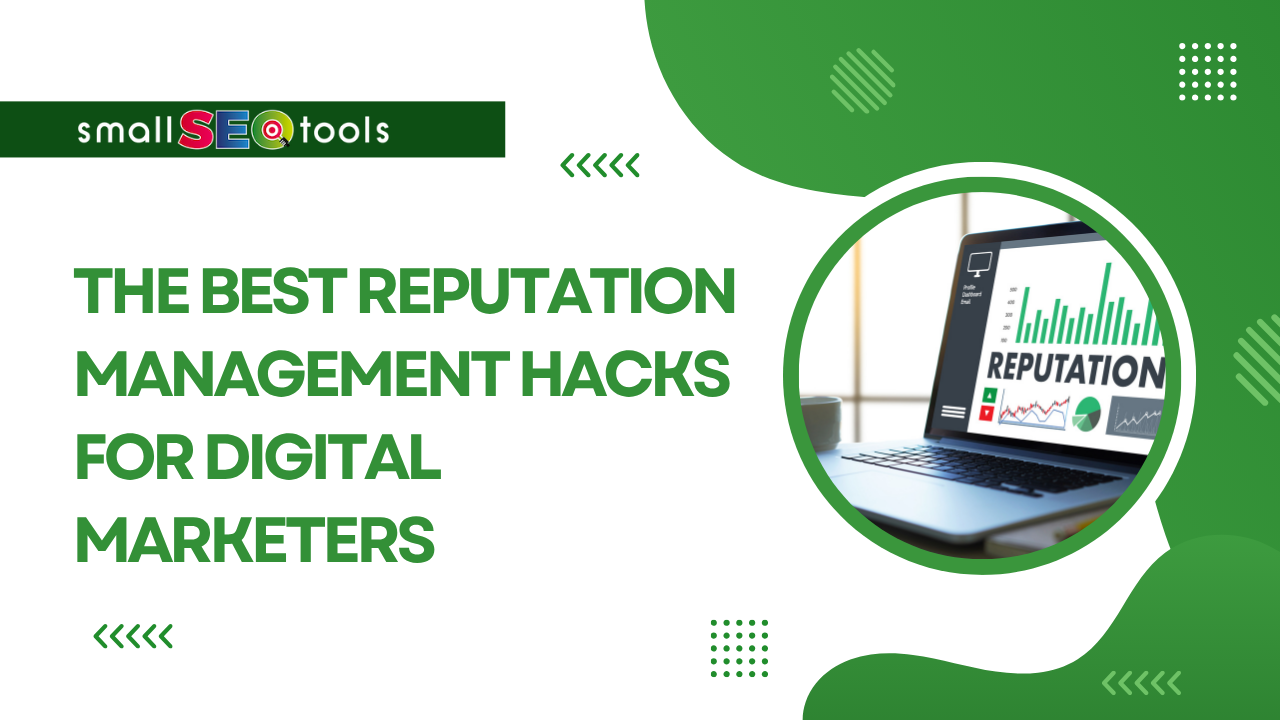The Best Reputation Management Hacks for Digital Marketers
If you're a marketer, your brand is online 24/7. What people see about you — or your clients — can shape leads, sales, and trust in seconds. And the tricky part? You don’t always control it.
Reputation management isn’t just about looking good. It’s about staying in the game. If someone Googles you and finds bad reviews or outdated blog posts, you lose before you even pitch. That’s why reputation management has become one of the core skills every marketer should have.

Here are the best hacks to manage online reputation and protect your brand like a pro.
Audit Yourself Regularly
You can’t fix what you can’t see.
Start by Googling your name, brand, and key product terms once a month. Use incognito mode so you see what the public sees. Check Google, Bing, images, and review platforms.
Make a list of:
- Negative links
- Outdated content
- Broken pages
- Review scores across platforms
- Suggested search terms (they matter more than you think)
One marketer we talked to said, “I caught a spammy blog post ranking for our brand name just by searching once a week. If I hadn’t checked, it could’ve stuck for months.”
Use this as your baseline. Revisit it often.
Set Up Alerts That Actually Work
Google Alerts is free and easy to use. Set alerts for:
- Your full name
- Brand name
- Product names
- Executive team
- High-value keywords
Use quotes around phrases for exact matches.
For example:
"Acme Marketing", not just Acme Marketing
Also try Mention or Brand24 for deeper tracking. These platforms scan social posts, blogs, and forums in real-time.
If something negative pops up, you’ll know fast — and can act faster.
Learn to Remove What You Can
Some content can be taken down. You just have to ask the right way.
What You Can Usually Remove:
- Inaccurate Google reviews
- Old press releases you published
- Your own blog posts that no longer help
- Outdated staff listings or bios
- Social posts violating a platform’s policy
If it’s a fake review or breaks content rules, you can remove negative Google reviews by reporting them. Use Google Business Profile to flag fake, spammy, or irrelevant comments.
Don't argue in public. File a request and wait for a response. If that fails, escalate with documentation.
For articles or forum posts, reach out directly. Be polite. Give a reason. Offer to replace the story or provide updated info.
Control Page One of Google
The goal is to fill page one of Google with stuff you want people to see. That means building and maintaining high-authority content.
Publish on:
- Your website (with your name and brand in the title tags)
- Medium
- Guest posts on industry blogs
- Press releases that stick
Own your name across platforms. Even if you're not active on Pinterest or Reddit, grab the handle to protect your brand. These sites rank well and take up space.
Tip: Use schema markup to boost click-through and visibility on Google. Add it to your About pages, product pages, and blog posts.
Respond to Reviews Like a Pro
Bad reviews happen. How you respond is what people really notice.
Be quick. Be calm. Be human.
- Say thanks (even to the angry ones)
- Acknowledge the issue
- Offer to fix it or take it offline
- Sign off with a real name
Example:
“Hi John, thanks for the feedback. I’m sorry we missed the mark. I’d love to learn more — please reach out directly so we can make it right. – Sarah, Customer Care Lead”
This shows future customers you care. Most people read responses more than the reviews themselves.
Build Positive Content in Advance
Don’t wait until there’s a problem. Build good content before bad stuff shows up.
Post often. Update bios. Share customer wins. Publish interviews, testimonials, and staff stories.
One SaaS founder told us, “We post a client case study every month. It’s not just for leads — it pushes down older articles we didn’t love.”
The key? Be consistent. Google likes fresh content. So do people.
Get in Front of Suggested Search Terms
Autocomplete can boost or kill your rep.
Start typing your brand or name into Google. See what fills in after. If you see “scam,” “lawsuit,” or “reviews,” those are real search patterns — not guesses.
Create content to control those terms.
For example, if “Acme Marketing Reviews” shows up, write a real blog post titled “Acme Marketing Reviews: What Our Clients Are Saying.” Fill it with testimonials, case studies, and context. Make it rank.
You won’t erase the bad searches, but you can guide what people find next.
Use SEO Like a Shield
Reputation and SEO go hand in hand.
To push negative links down, you need stronger content above them. That means:
- Using keywords smartly in your posts and bios
- Getting backlinks from solid sources
- Keeping your top pages updated regularly
- Adding media (images, video, podcast clips) to boost engagement
Don’t just rely on your homepage. Spread the authority across pages.
A content marketer we spoke to said, “We created a ‘Meet the Team’ page that ranked higher than a bad Reddit thread. Simple, clean SEO saved us thousands in PR.”
Keep Social Profiles Clean and Branded
Social media pages rank fast. Keep them active and on-brand.
Use the same profile photo, bio, and links across platforms. Post weekly if possible. Even short updates help Google crawl and trust the page.
Double-check your privacy settings. Make sure old posts, tweets, or photos can’t resurface and cause problems. There are tools to scan old posts and help remove them if needed.
One PR manager admitted, “A 2014 tweet almost cost a client a speaking gig. We found it, deleted it, and updated their bio everywhere. Now we audit every 90 days.”
Don’t Wait for a Crisis
The worst time to start reputation work is during a meltdown.
Start now. Build a system. Assign a team member or set calendar reminders. Treat it like maintenance — not a panic button.
Even if you don’t need it today, future-you will be glad you put the work in early.
Final Thoughts
Reputation isn’t luck. It’s strategy.
With a few smart hacks, digital marketers can stay ahead of the curve and keep search results clean, sharp, and trustworthy.
Remember:
- Audit monthly
- Own your top results
- Remove what you can
- Build before there’s trouble
- Respond like a real human
- Use SEO to lead, not just follow
You don’t need a PR firm for every issue. Just a plan, the right tools, and a clear idea of how you want to show up online. Because when someone searches for your name, the story should be yours — not someone else’s.
leave a comment
Please post your comments here.SEARCH
-
Popular SEO Tools
- Paraphrasing Tool
- Plagiarism Checker
- Article Spinner / Rewriter
- Keyword Position Checker
- Grammar Check
- Domain Authority Checker
- Pagespeed Insights Checker
- Reverse Image Search
- Page Authority checker
- Backlink Checker
- Alexa Rank Checker
- Backlink Maker
- Domain Age Checker
- Website Ping Tool
- Website Seo Score Checker
- Keyword Density Checker
- Website Page Size Checker
- Word Count Checker
- Mozrank Checker

 ™
™